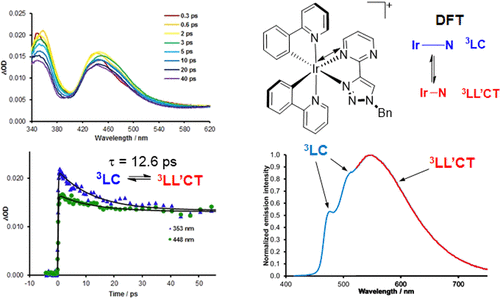当前位置:
X-MOL 学术
›
Inorg. Chem.
›
论文详情
Our official English website, www.x-mol.net, welcomes your
feedback! (Note: you will need to create a separate account there.)
Unravelling the Mechanism of Excited-State Interligand Energy Transfer and the Engineering of Dual Emission in [Ir(C∧N)2(N∧N)]+ Complexes.
Inorganic Chemistry ( IF 4.3 ) Pub Date : 2020-01-14 , DOI: 10.1021/acs.inorgchem.9b03003 Paul A Scattergood 1, 2 , Anna M Ranieri 3 , Luke Charalambou 1 , Adrian Comia 1 , Daniel A W Ross 1 , Craig R Rice 1 , Samantha J O Hardman 4 , Jean-Louis Heully 5 , Isabelle M Dixon 5 , Massimiliano Massi 3 , Fabienne Alary 5 , Paul I P Elliott 1, 2
Inorganic Chemistry ( IF 4.3 ) Pub Date : 2020-01-14 , DOI: 10.1021/acs.inorgchem.9b03003 Paul A Scattergood 1, 2 , Anna M Ranieri 3 , Luke Charalambou 1 , Adrian Comia 1 , Daniel A W Ross 1 , Craig R Rice 1 , Samantha J O Hardman 4 , Jean-Louis Heully 5 , Isabelle M Dixon 5 , Massimiliano Massi 3 , Fabienne Alary 5 , Paul I P Elliott 1, 2
Affiliation

|
Fundamental insights into the mechanism of triplet-excited-state interligand energy transfer dynamics and the origin of dual emission for phosphorescent iridium(III) complexes are presented. The complexes [Ir(C∧N)2(N∧N)]+ (HC∧N = 2-phenylpyridine (1a-c), 2-(2,4-difluorophenyl)pyridine (2a-c), 1-benzyl-4-phenyl-1,2,3-triazole (3a-c); N∧N = 1-benzyl-4-(pyrid-2-yl)-1,2,3-triazole (pytz, a), 1-benzyl-4-(pyrimidin-2-yl)-1,2,3-triazole (pymtz, b), 1-benzyl-4-(pyrazin-2-yl)-1,2,3-triazole (pyztz, c)) are phosphorescent in room-temperature fluid solutions from triplet metal-to-ligand charge transfer (3MLCT) states admixed with either ligand-centered (3LC) (1a, 2a, and 2b) or ligand-to-ligand charge transfer (3LL'CT) character (1c, 2c, and 3a-c). Particularly striking is the observation that pyrimidine-based complex 1b exhibits dual emission from both 3MLCT/3LC and 3MLCT/3LL'CT states. At 77 K, the 3MLCT/3LL'CT component is lost from the photoluminescence spectra of 1b, with emission exclusively arising from its 3MLCT/3LC state, while for 2c switching from 3MLCT/3LL'CT- to 3MLCT/3LC-based emission is observed. Femtosecond transient absorption data reveal distinct spectral signatures characteristic of the population of 3MLCT/3LC states for 1a, 2a, and 2b which persist throughout the 3 ns time frame of the experiment. These 3MLCT/3LC state signatures are apparent in the transient absorption spectra for 1c and 2c immediately following photoexcitation but rapidly evolve to yield spectral profiles characteristic of their 3MLCT/3LL'CT states. Transient data for 1b reveals intermediate behavior: the spectral features of the initially populated 3MLCT/3LC state also undergo rapid evolution, although to a lesser extent than that observed for 1c and 2c, behavior assigned to the equilibration of the 3MLCT/3LC and 3MLCT/3LL'CT states. Density functional theory (DFT) calculations enabled minima to be optimized for both 3MLCT/3LC and 3MLCT/3LL'CT states of 1a-c and 2a-c. Indeed, two distinct 3MLCT/3LC minima were optimized for 1a, 1b, 2a, and 2b distinguished by upon which of the two C∧N ligands the excited electron resides. The 3MLCT/3LC and 3MLCT/3LL'CT states for 1b are very close in energy, in excellent agreement with experimental data demonstrating dual emission. Calculated vibrationally resolved emission spectra (VRES) for the complexes are in excellent agreement with experimental data, with the overlay of spectral maxima arising from emission from the 3MLCT/3LC and 3MLCT/3LL'CT states of 1b convincingly reproducing the observed experimental spectral features. Analysis of the optimized excited-state geometries enable the key structural differences between the 3MLCT/3LC and 3MLCT/3LL'CT states of the complexes to be identified and quantified. The calculation of interconversion pathways between triplet excited states provides for the first time a through-space mechanism for a photoinduced interligand energy transfer process. Furthermore, examination of structural changes between the possible emitting triplet excited states reveals the key bond vibrations that mediate energy transfer between these states. This work therefore provides for the first time detailed mechanistic insights into the fundamental photophysical processes of this important class of complexes.
中文翻译:

[Ir(C∧N)2(N∧N)] +配合物激发态配体能量转移机理及双重发射工程研究。
提出了有关三重态激发态配体能量转移动力学机制以及磷光铱(III)络合物双重发射起源的基本见解。配合物[Ir(C∧N)2(N∧N)] +(HC∧N= 2-苯基吡啶(1a-c),2-(2,4-二氟苯基)吡啶(2a-c),1-苄基-4-苯基-1,2,3-三唑(3a-c); N = N = 1-苄基-4-(吡啶-2-基)-1,2,3-三唑(pytz,a),1 -苄基-4-(嘧啶-2-基)-1,2,3-三唑(pymtz,b),1-苄基-4-(吡嗪-2-基)-1,2,3-三唑(pyztz, c))在室温流体溶液中由三重态金属到配体的电荷转移(3MLCT)状态与以配体为中心的(3LC)(1a,2a和2b)或配体到配体的电荷转移( 3LL'CT)字符(1c,2c和3a-c)。特别令人惊奇的是,基于嘧啶的络合物1b在3MLCT / 3LC和3MLCT / 3LL'CT状态下均呈现双重发射。在77 K时,1b的光致发光光谱中丢失了3MLCT / 3LL'CT分量,其发射仅由其3MLCT / 3LC状态引起,而对于2c,则从3MLCT / 3LL'CT-转换为基于3MLCT / 3LC的发射是观测到的。飞秒瞬态吸收数据揭示了针对1a,2a和2b的3MLCT / 3LC状态种群的独特光谱特征,该特征在实验的3 ns时间内一直持续。这些3MLCT / 3LC状态标记在光激发后立即在1c和2c的瞬态吸收光谱中显而易见,但迅速演变为它们的3MLCT / 3LL'CT状态的光谱轮廓。1b的瞬态数据显示出中间行为:最初填充的3MLCT / 3LC状态的光谱特征也经历了快速演变,尽管程度比1c和2c观察到的要小,这些行为被分配给3MLCT / 3LC和3MLCT / 3LL'CT州。密度泛函理论(DFT)计算使最小值能够针对1a-c和2a-c的3MLCT / 3LC和3MLCT / 3LL'CT状态进行优化。实际上,针对1a,1b,2a和2b优化了两个截然不同的3MLCT / 3LC最小值,区别在于受激电子位于两个C∧N配体中的哪个。1b的3MLCT / 3LC和3MLCT / 3LL'CT状态的能量非常接近,与证明双发射的实验数据非常吻合。配合物的振动解析发射光谱(VRES)与实验数据非常吻合,光谱最大值的叠加来自1b的3MLCT / 3LC和3MLCT / 3LL'CT状态的发射,令人信服地再现了观察到的实验光谱特征。通过对优化的激发态几何结构进行分析,可以识别和量化配合物的3MLCT / 3LC和3MLCT / 3LL'CT状态之间的关键结构差异。三重激发态之间的相互转换途径的计算首次为光诱导的配体能量转移过程提供了一种穿越空间的机制。此外,对可能的发射三重态激发态之间的结构变化的研究揭示了介导这些状态之间能量转移的关键键振动。因此,这项工作首次为这种重要的复合物类的基本光物理过程提供了详细的机械原理。
更新日期:2020-01-15
中文翻译:

[Ir(C∧N)2(N∧N)] +配合物激发态配体能量转移机理及双重发射工程研究。
提出了有关三重态激发态配体能量转移动力学机制以及磷光铱(III)络合物双重发射起源的基本见解。配合物[Ir(C∧N)2(N∧N)] +(HC∧N= 2-苯基吡啶(1a-c),2-(2,4-二氟苯基)吡啶(2a-c),1-苄基-4-苯基-1,2,3-三唑(3a-c); N = N = 1-苄基-4-(吡啶-2-基)-1,2,3-三唑(pytz,a),1 -苄基-4-(嘧啶-2-基)-1,2,3-三唑(pymtz,b),1-苄基-4-(吡嗪-2-基)-1,2,3-三唑(pyztz, c))在室温流体溶液中由三重态金属到配体的电荷转移(3MLCT)状态与以配体为中心的(3LC)(1a,2a和2b)或配体到配体的电荷转移( 3LL'CT)字符(1c,2c和3a-c)。特别令人惊奇的是,基于嘧啶的络合物1b在3MLCT / 3LC和3MLCT / 3LL'CT状态下均呈现双重发射。在77 K时,1b的光致发光光谱中丢失了3MLCT / 3LL'CT分量,其发射仅由其3MLCT / 3LC状态引起,而对于2c,则从3MLCT / 3LL'CT-转换为基于3MLCT / 3LC的发射是观测到的。飞秒瞬态吸收数据揭示了针对1a,2a和2b的3MLCT / 3LC状态种群的独特光谱特征,该特征在实验的3 ns时间内一直持续。这些3MLCT / 3LC状态标记在光激发后立即在1c和2c的瞬态吸收光谱中显而易见,但迅速演变为它们的3MLCT / 3LL'CT状态的光谱轮廓。1b的瞬态数据显示出中间行为:最初填充的3MLCT / 3LC状态的光谱特征也经历了快速演变,尽管程度比1c和2c观察到的要小,这些行为被分配给3MLCT / 3LC和3MLCT / 3LL'CT州。密度泛函理论(DFT)计算使最小值能够针对1a-c和2a-c的3MLCT / 3LC和3MLCT / 3LL'CT状态进行优化。实际上,针对1a,1b,2a和2b优化了两个截然不同的3MLCT / 3LC最小值,区别在于受激电子位于两个C∧N配体中的哪个。1b的3MLCT / 3LC和3MLCT / 3LL'CT状态的能量非常接近,与证明双发射的实验数据非常吻合。配合物的振动解析发射光谱(VRES)与实验数据非常吻合,光谱最大值的叠加来自1b的3MLCT / 3LC和3MLCT / 3LL'CT状态的发射,令人信服地再现了观察到的实验光谱特征。通过对优化的激发态几何结构进行分析,可以识别和量化配合物的3MLCT / 3LC和3MLCT / 3LL'CT状态之间的关键结构差异。三重激发态之间的相互转换途径的计算首次为光诱导的配体能量转移过程提供了一种穿越空间的机制。此外,对可能的发射三重态激发态之间的结构变化的研究揭示了介导这些状态之间能量转移的关键键振动。因此,这项工作首次为这种重要的复合物类的基本光物理过程提供了详细的机械原理。









































 京公网安备 11010802027423号
京公网安备 11010802027423号